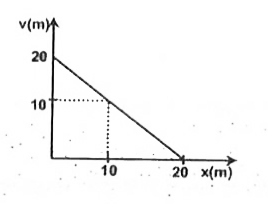A body of mass 2kg is moving on a smooth floor in straight line with a uniform velocity of Resultant force on the body is
20N
10N
2N
Zero
The correct Answer is:D
To solve the problem, we need to determine the resultant force acting on a body of mass 2 kg moving with a uniform velocity of 10 m/s on a smooth floor. Here’s the step-by-step solution:
Step 1: Understand the Motion
The body is moving with a uniform velocity of 10 m/s. This means that both the speed and direction of the body are constant.
Hint: Recall that uniform velocity means no change in speed or direction.
Step 2: Identify the Acceleration
Since the body is moving with a uniform velocity, there is no change in its velocity. Therefore, the acceleration of the body is zero.
Hint: Remember that acceleration is defined as the rate of change of velocity. If velocity is constant, acceleration is zero.
Step 3: Apply Newton's Second Law of Motion
According to Newton's second law of motion, the resultant force (F_r) acting on an object is given by the formula:
Fr=m⋅a
where:
- Fr is the resultant force,
- m is the mass of the body,
- a is the acceleration.
Step 4: Substitute the Values
We know:
- Mass m=2 kg,
- Acceleration a=0 m/s² (from Step 2).
Now substituting these values into the formula:
Fr=2kg⋅0m/s2=0N
Hint: When multiplying any number by zero, the result is always zero.
Step 5: Conclusion
The resultant force acting on the body is 0 N.
Final Answer: The resultant force on the body is 0 N.
The body is moving with a uniform velocity of 10 m/s. This means that both the speed and direction of the body are constant.
Since the body is moving with a uniform velocity, there is no change in its velocity. Therefore, the acceleration of the body is zero.
According to Newton's second law of motion, the resultant force (F_r) acting on an object is given by the formula:
Fr=m⋅a
where:
- Fr is the resultant force,
- m is the mass of the body,
- a is the acceleration.
We know:
- Mass m=2 kg,
- Acceleration a=0 m/s² (from Step 2).
Fr=2kg⋅0m/s2=0N
The resultant force acting on the body is 0 N.
Topper's Solved these Questions
- FORCE AND LAWS OF MOTIONBOOK - MTG IIT JEE FOUNDATIONCHAPTER - FORCE AND LAWS OF MOTIONEXERCISE - EXERCISE (INTEGER VALUE TYPE )
5 Videos
- FOOTSTEPS TOWARDS NEETBOOK - MTG IIT JEE FOUNDATIONCHAPTER - FOOTSTEPS TOWARDS NEETEXERCISE - Multiple Choice Question
45 Videos
- GRAVITATION BOOK - MTG IIT JEE FOUNDATIONCHAPTER - GRAVITATION EXERCISE - Olympiad/HOTS Corner
20 Videos
Similar Questions
A body of mass 5kg is moving along a circle of radius 1m with a uniform speed of 5m/s. The external force acting on the body is
View SolutionIf a body of mass 5 kg is moving in a circle of radius 5 m with a velocity 100 m/s, then the centripetal force acting on the body is 10xN , where the value of x is____.
View Solution
Knowledge Check
A body of mass 1kg is moving along a straight line with a velocity of 1m/s. The external force acting in the body is
A1NB1 dyneC1JDzeroA body moves on a straight line with a uniform velocity Its angular momentum
Ais zero about a point on the straight line.Bremains constant about any given point.Cis always zero.Dis not zero about a point away from the straight line.A body of mass 10 kg is moving in a circle of radian 1 m with an angular velocity of 2rad/s the centripetal force is
A10 NB40 NC30 ND20 N
A body of mass 2 kg is moving in straight line for which v - x graph is shown in the figure. Magnitude of force acting on the body at x = 10 m is 5k N. Find the value of k.

View SolutionA body of mass 5kg is moving along a circle of a radius 1m with a uniform speed of 5 ms.What is the acceleration of body?
View SolutionThe initial velocity of a body moving along a straight lines is 7m/s. It has a uniform acceleration of 4m/s2 the distance covered by the body in the 5th second of its motion is-
View SolutionA body of mass 10 kg is moving on a horizonal surface be applying a force of 10 N in the forward direction. The body moves with a constant velocity of 0.2ms−1. Work done by the force of friction in the first 10 seconds is
View SolutionA body of mass 5 kg is moving in a circle of radius m 1 with an angular velocity of 2 radian/sec . The centripetal force is
View Solution
